 Those pesky love bugs can strike when we are most unaware or most disinterested in being bitten. But love and Valentine’s Day don’t always have to be associated with romance. Sometimes this holiday can be the perfect time to celebrate the things and people we love the most, including family, friends and jokes about the all-too confusing nature of love. This week’s reviews from members of the IRA Children’s Literature and Reading Special Interest Group just may expand your definition of love. Teachers may want to visit ReadWriteThink, which provides several lesson ideas for Valentine’s Day and more.
Those pesky love bugs can strike when we are most unaware or most disinterested in being bitten. But love and Valentine’s Day don’t always have to be associated with romance. Sometimes this holiday can be the perfect time to celebrate the things and people we love the most, including family, friends and jokes about the all-too confusing nature of love. This week’s reviews from members of the IRA Children’s Literature and Reading Special Interest Group just may expand your definition of love. Teachers may want to visit ReadWriteThink, which provides several lesson ideas for Valentine’s Day and more.
Grades K-3
Bozzo, Linda. (2013). Funny Valentine’s Day jokes to tickle your funny bone. Berkeley Heights, NJ: Enslow Elementary.
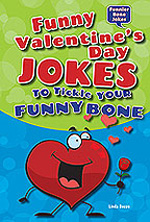 Elementary school children will enjoy reading and sharing with classmates and adults the many Valentine's Day jokes in this particular title. There are plenty of knock, knock jokes and some groaners, but there are also several jokes guaranteed to make anyone laugh out loud. Rather than reach for a chocolate, the lovelorn might be well-advised to reach for a joke or two. This one would be useful in a unit on word play too.
Elementary school children will enjoy reading and sharing with classmates and adults the many Valentine's Day jokes in this particular title. There are plenty of knock, knock jokes and some groaners, but there are also several jokes guaranteed to make anyone laugh out loud. Rather than reach for a chocolate, the lovelorn might be well-advised to reach for a joke or two. This one would be useful in a unit on word play too.
- Barbara A. Ward, Washington State University Pullman
Farmer, Jacqueline. (2013). Valentine be mine. Illus. by Megan Halsey and Sean Addy. Watertown, MA: Charlesbridge.
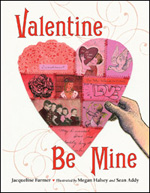 This visually interesting and well-researched book provides the history of Valentine’s Day and its romantic associations. Drawing from its possible inception during Roman times, the author provides several scenarios, from pagan to religious, on the origin and evolving celebrations that accompany Valentine’s Day. Stories, legends, and traditions for young readers, historical facts, jokes, activities, and more are found within these pages that are decorated with collages that offer a feast for the eyes. Craft and construction paper ideas and, of course, the popularity of chocolate attached to this holiday are also part of the treats offered within this book. This nonfiction look at Valentine’s Day is a wonderful addition to any classroom or library. Although intended for booksellers, teachers will enjoy the toolkit resources for bookmarks and mini-posters that are available at the publisher’s website.
This visually interesting and well-researched book provides the history of Valentine’s Day and its romantic associations. Drawing from its possible inception during Roman times, the author provides several scenarios, from pagan to religious, on the origin and evolving celebrations that accompany Valentine’s Day. Stories, legends, and traditions for young readers, historical facts, jokes, activities, and more are found within these pages that are decorated with collages that offer a feast for the eyes. Craft and construction paper ideas and, of course, the popularity of chocolate attached to this holiday are also part of the treats offered within this book. This nonfiction look at Valentine’s Day is a wonderful addition to any classroom or library. Although intended for booksellers, teachers will enjoy the toolkit resources for bookmarks and mini-posters that are available at the publisher’s website.
- Karen Hildebrand, Ohio Library and Reading Consultant
Ferber, Brenda A. (2012). The yuckiest, stinkiest, best Valentine ever. Illus. by Tedd Arnold. New York: Dial Books for Young Readers.
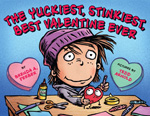 As the story opens, Leon is making a red construction paper heart Valentine for Zoey Maloney, the girl with whom he has fallen madly in love. When he writes “I love you” on the back of the Valentine, the Valentine comes to life and responds with “Yuck” and goes on to inform Leon that he will make a fool of himself if he gives this heart to Zoey. He continues to say that Valentine’s Day is about CANDY, not love. And with that, he hops out the window and runs away. The chase is on as Leon runs after this runaway heart. Along the way, Leon finds others that are tagging along to help catch the fleet-footed heart. As Leon explains the reason for the chase, his friends offer different views on love, from boys who agree with the heart to girls who think it is sweet and are ready to swoon. Before reading this book, teachers might consider reading aloud one or more versions of The Gingerbread Boy so that the comparison to this yucky Valentine tale can be enjoyed on different comparative levels. Arnold’s cartoon-like illustrations, especially the expressions he draws on the face of the red heart, are hilarious. A sure hit at any classroom Valentine’s party, this title begs to be a Valentine’s Day read aloud. Teachers will enjoy the colorful resource activity kit available at the author’s website in addition to an author interview on how she was inspired to write this book, which is based on her son’s school Valentine experience.
As the story opens, Leon is making a red construction paper heart Valentine for Zoey Maloney, the girl with whom he has fallen madly in love. When he writes “I love you” on the back of the Valentine, the Valentine comes to life and responds with “Yuck” and goes on to inform Leon that he will make a fool of himself if he gives this heart to Zoey. He continues to say that Valentine’s Day is about CANDY, not love. And with that, he hops out the window and runs away. The chase is on as Leon runs after this runaway heart. Along the way, Leon finds others that are tagging along to help catch the fleet-footed heart. As Leon explains the reason for the chase, his friends offer different views on love, from boys who agree with the heart to girls who think it is sweet and are ready to swoon. Before reading this book, teachers might consider reading aloud one or more versions of The Gingerbread Boy so that the comparison to this yucky Valentine tale can be enjoyed on different comparative levels. Arnold’s cartoon-like illustrations, especially the expressions he draws on the face of the red heart, are hilarious. A sure hit at any classroom Valentine’s party, this title begs to be a Valentine’s Day read aloud. Teachers will enjoy the colorful resource activity kit available at the author’s website in addition to an author interview on how she was inspired to write this book, which is based on her son’s school Valentine experience.
- Karen Hildebrand, Ohio Library and Reading Consultant
Kirk, Daniel. (2013). Ten things I love about you. New York: Penguin Group Publishers/Nancy Paulsen Books.
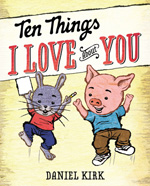 Rabbit and Pig are good friends. Rabbit decides he wants to make a list of all the things he really likes about his friend, but he picks a time when Pig is really busy doing other things. As Rabbit follows Pig around asking for his help on this new project, he joyously adds things to the list that note Pig’s wonderful qualities. Pig is starting to grow a little impatient with what he perceives as being badgered by Rabbit. However, Rabbit just adds to the list how polite Pig is when he emphatically says, “Please, Rabbit!” (unpaged). The story concludes when Pig drops a piece of paper, and readers find out that Pig is a list-maker, too! Kirk’s illustrations are not the usual style readers see in his Library Mouse series. For this book he has used painted wood panels and ink-on-paper drawings that are scanned into a computer and then enhanced through digital art tools. The lists in the book will give teachers a jumping off point for writing ideas for students or they may decide to use Georgia Heard’s Falling down the Page: A Book of List Poems (2009) to create poems from children’s ideas, individually or a class poem. Teachers who are looking for authors that Skype will find that information and a great deal more at the author’s website.
Rabbit and Pig are good friends. Rabbit decides he wants to make a list of all the things he really likes about his friend, but he picks a time when Pig is really busy doing other things. As Rabbit follows Pig around asking for his help on this new project, he joyously adds things to the list that note Pig’s wonderful qualities. Pig is starting to grow a little impatient with what he perceives as being badgered by Rabbit. However, Rabbit just adds to the list how polite Pig is when he emphatically says, “Please, Rabbit!” (unpaged). The story concludes when Pig drops a piece of paper, and readers find out that Pig is a list-maker, too! Kirk’s illustrations are not the usual style readers see in his Library Mouse series. For this book he has used painted wood panels and ink-on-paper drawings that are scanned into a computer and then enhanced through digital art tools. The lists in the book will give teachers a jumping off point for writing ideas for students or they may decide to use Georgia Heard’s Falling down the Page: A Book of List Poems (2009) to create poems from children’s ideas, individually or a class poem. Teachers who are looking for authors that Skype will find that information and a great deal more at the author’s website.
- Karen Hildebrand, Ohio Library and Reading Consultant
Kranz, Linda. (2012). Love you when. Photos by Klaus Kranz. Lanham, MD: Rowan Littlefield Publishing Group/Taylor Trade Publishing.
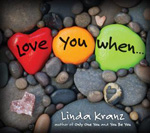 “Do you think of me during the day?” you ask … “Tell me when” (p.1). This little book that appears to be told from parent to child or grandchild goes on to answer the question of when the adult thinks of the child in everyday settings. Using natural as well as painted and/or decorated rocks, the author presents different scenarios throughout the day when the adult thinks of the child; for example, from the morning sun or the smell of flowers. Beautifully illustrated with a motif of rocks and stones, this might be a more personal book as a gift. Teachers will enjoy the writing pattern templates on the author’s website.
“Do you think of me during the day?” you ask … “Tell me when” (p.1). This little book that appears to be told from parent to child or grandchild goes on to answer the question of when the adult thinks of the child in everyday settings. Using natural as well as painted and/or decorated rocks, the author presents different scenarios throughout the day when the adult thinks of the child; for example, from the morning sun or the smell of flowers. Beautifully illustrated with a motif of rocks and stones, this might be a more personal book as a gift. Teachers will enjoy the writing pattern templates on the author’s website.
- Karen Hildebrand, Ohio Library and Reading Consultant
Manushkin, Fran. (2011). Katie Woo: No Valentines for Katie. Illus. by Tammie Lyon. Mankato, MN: Capstone/Picture Window Books.
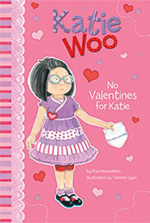 The giving and receiving of Valentines can be exciting or traumatic. When exuberant Katie doesn't receive a Valentine from the box Miss Winkle has placed in class for the cards for her students, she is hurt until the reason for the slight is discovered. It turns out that she has plenty of friends, and she and Barry, the new boy in class, have a lot more in common than their glasses. This is a sweet way to discuss the feeling of being left out although Katie is upset over nothing in the end. It’s also a gentle reminder not to forget that everyone needs a little love now and then. The illustrations capture the sweet nature of Katie and her classmates.
The giving and receiving of Valentines can be exciting or traumatic. When exuberant Katie doesn't receive a Valentine from the box Miss Winkle has placed in class for the cards for her students, she is hurt until the reason for the slight is discovered. It turns out that she has plenty of friends, and she and Barry, the new boy in class, have a lot more in common than their glasses. This is a sweet way to discuss the feeling of being left out although Katie is upset over nothing in the end. It’s also a gentle reminder not to forget that everyone needs a little love now and then. The illustrations capture the sweet nature of Katie and her classmates.
- Barbara A. Ward, Washington State University Pullman
Rotner, Shelley. (2013). What’s love? Mankato, MN: Capstone Press.
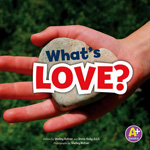 First published in 2008 by Roaring Brook Press using black and white photographs, this 2013 edition has added beautiful color photography and a variety of fonts to pose the title question: What is love? Sometimes tangible and sometimes not, the concept of love can be answered for children with a wide range of responses. “Love opens our hearts/ It makes us giggle and sometimes cry/” (p. 6-7) “We love the buzz/ of ideas and/ stories in our heads.” (p. 24). Teachers will enjoy using this book as a read-aloud that might inspire some creative writing or at the very least thoughtful brainstorming. Or possibly it will inspire a little more love throughout the classroom community.
First published in 2008 by Roaring Brook Press using black and white photographs, this 2013 edition has added beautiful color photography and a variety of fonts to pose the title question: What is love? Sometimes tangible and sometimes not, the concept of love can be answered for children with a wide range of responses. “Love opens our hearts/ It makes us giggle and sometimes cry/” (p. 6-7) “We love the buzz/ of ideas and/ stories in our heads.” (p. 24). Teachers will enjoy using this book as a read-aloud that might inspire some creative writing or at the very least thoughtful brainstorming. Or possibly it will inspire a little more love throughout the classroom community.
- Karen Hildebrand, Ohio Library and Reading Consultant
Grades 4-7
Krishnaswami, Uma. (2013). The problem with being slightly heroic. Illus. by Abigail Halpin. New York: Simon & Schuster/Atheneum Books for Young Readers.
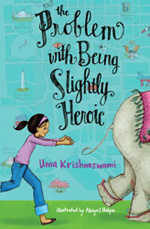 Some love stories occur in privacy while others play out between one person and millions of admirers or fans. In this book, the love story of Dolly Singh, a celebrated movie star, is of great interest to her fans in India and America. The sequel to the earlier The Grand Plan to Fix Everything (2011), this title brings Dolly and Dini to the U. S. where Dolly’s latest movie has its inaugural screening. Naturally, Dini and her friend and fan Maddie are thrilled, but oh, so much can also go wrong. Dolly loses her passport, but luckily evades the darts that were meant for Mini the truant elephant who has strolled out of her restricted yard at the Smithsonian Institution. She must deal with scattered jewelry and a fiancé who has been darted instead of Mini. With so much going on, Dolly needs her milkshake with its special rose petal ingredients to relax her. Dini finds allies in the kitchen where Armend Latifi rules with an iron fist and is able to negotiate for the supply of rose petals with a touch of chocolate, just the way Dolly loves it. Somehow, Dolly has befriended Mini, the adventurous elephant, and takes off to spend time with her without telling anyone. The flowing pencil sketches and the light-hearted text come together beautifully (and amusingly) in this book.
Some love stories occur in privacy while others play out between one person and millions of admirers or fans. In this book, the love story of Dolly Singh, a celebrated movie star, is of great interest to her fans in India and America. The sequel to the earlier The Grand Plan to Fix Everything (2011), this title brings Dolly and Dini to the U. S. where Dolly’s latest movie has its inaugural screening. Naturally, Dini and her friend and fan Maddie are thrilled, but oh, so much can also go wrong. Dolly loses her passport, but luckily evades the darts that were meant for Mini the truant elephant who has strolled out of her restricted yard at the Smithsonian Institution. She must deal with scattered jewelry and a fiancé who has been darted instead of Mini. With so much going on, Dolly needs her milkshake with its special rose petal ingredients to relax her. Dini finds allies in the kitchen where Armend Latifi rules with an iron fist and is able to negotiate for the supply of rose petals with a touch of chocolate, just the way Dolly loves it. Somehow, Dolly has befriended Mini, the adventurous elephant, and takes off to spend time with her without telling anyone. The flowing pencil sketches and the light-hearted text come together beautifully (and amusingly) in this book.
- Rani Iyer, Washington State University Pullman
McMullan, Kate. (2012). Nice shot, Cupid! Mankato, MN: Stone Arch Books/Capstone Press.
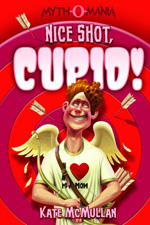 From the Myth-O-Mania series from Kate McMullen, the author uses the voice of Hades to tell this story in updated contemporary language and setting. The teenaged god Cupid, complete with braces and pimples, falls in love with the beautiful mortal young girl, Psyche. Shy and somewhat bumbling, Cupid is reluctant to approach her so Zeus comes up with a plan to bring them together – a kidnapping! Using a humorous tone to tell the tale, the author is sure to captivate today’s young readers with the pop culture references, the lattes, Hades’ horses Harley and Davidson and other jokes and laughter without straying too far from the original Greek myth. Also listen to the audio book summary of the book.
From the Myth-O-Mania series from Kate McMullen, the author uses the voice of Hades to tell this story in updated contemporary language and setting. The teenaged god Cupid, complete with braces and pimples, falls in love with the beautiful mortal young girl, Psyche. Shy and somewhat bumbling, Cupid is reluctant to approach her so Zeus comes up with a plan to bring them together – a kidnapping! Using a humorous tone to tell the tale, the author is sure to captivate today’s young readers with the pop culture references, the lattes, Hades’ horses Harley and Davidson and other jokes and laughter without straying too far from the original Greek myth. Also listen to the audio book summary of the book.
- Karen Hildebrand, Ohio Library and Reading Consultant
Grades 9-12
Couloumbis, Audrey. (2012). Not exactly a love story. New York: Random House.
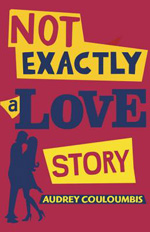 The setting is the 1970’s, the pre-cell phone era. Fifteen-year-old Vinnie is reeling with horrible acne, a girl friend who moved away without saying goodbye, his parents’ divorce, his mother’s remarriage (to Mr. Buonofuoco, his gym teacher!) and now a move from Queens to Long Island. Lonely and self-conscious, he has to find his way into a new life at a new school. He develops a crush on the very pretty girl next door, Patsy, but lacks the courage to approach her. When he accidentally finds her unlisted phone number on a slip of paper, he places an anonymous midnight phone call that turns into something rather obscene. Embarrassed at the way the nocturnal phone call has turned out, he calls back the next night to apologize, still not revealing who he really is. As he calls again the following night, the persona of “Vincenzo” takes shape. Patsy decides to carry on the conversations each night that he calls back. In a Cyrano de Bergerac style, their relationship evolves. Meanwhile, their daytime friendship is actually developing as well, and Patsy confides in Vincenzo that she is interested in Vinnie. Not surprisingly, the two eventually meet face to face when all is revealed and true identities, as well as inner feelings, are exposed. This charming almost-love story will appeal to teen readers.
The setting is the 1970’s, the pre-cell phone era. Fifteen-year-old Vinnie is reeling with horrible acne, a girl friend who moved away without saying goodbye, his parents’ divorce, his mother’s remarriage (to Mr. Buonofuoco, his gym teacher!) and now a move from Queens to Long Island. Lonely and self-conscious, he has to find his way into a new life at a new school. He develops a crush on the very pretty girl next door, Patsy, but lacks the courage to approach her. When he accidentally finds her unlisted phone number on a slip of paper, he places an anonymous midnight phone call that turns into something rather obscene. Embarrassed at the way the nocturnal phone call has turned out, he calls back the next night to apologize, still not revealing who he really is. As he calls again the following night, the persona of “Vincenzo” takes shape. Patsy decides to carry on the conversations each night that he calls back. In a Cyrano de Bergerac style, their relationship evolves. Meanwhile, their daytime friendship is actually developing as well, and Patsy confides in Vincenzo that she is interested in Vinnie. Not surprisingly, the two eventually meet face to face when all is revealed and true identities, as well as inner feelings, are exposed. This charming almost-love story will appeal to teen readers.
Teachers may want to watch this “60second Recap” of this book at or this interview with the author based on some of her earlier works and the research process.
- Karen Hildebrand, Ohio Library and Reading Consultant
Powell, Martin (reteller). (2012). Shakespeare: Romeo & Juliet. Illus. by Eva Cabrera. Mankato, MN: Capstone/Stone Arch Books.
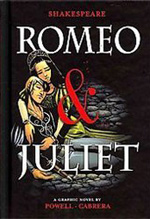 Although this graphic novel simplifies much of the classic star-crossed love story of Romeo and Juliet and the disagreement between the two families while also leaving out much of William Shakespeare's language, it still may find a receptive audience in readers struggling to understand the play’s nuances. Teachers might find it useful to hand this version to some of their students while discussing the various scenes. Juliet and Romeo are depicted as attractive youngsters, falling head over heels without knowing the other’s background. After sharing a kiss at a masked ball, both realize that they have been keeping company with their family’s enemy. It would be hard to find a more romantic or tragic story than this of Juliet and her Romeo. Moreover, it's encouraging to note that the Bard's story lives on in this particular format.
Although this graphic novel simplifies much of the classic star-crossed love story of Romeo and Juliet and the disagreement between the two families while also leaving out much of William Shakespeare's language, it still may find a receptive audience in readers struggling to understand the play’s nuances. Teachers might find it useful to hand this version to some of their students while discussing the various scenes. Juliet and Romeo are depicted as attractive youngsters, falling head over heels without knowing the other’s background. After sharing a kiss at a masked ball, both realize that they have been keeping company with their family’s enemy. It would be hard to find a more romantic or tragic story than this of Juliet and her Romeo. Moreover, it's encouraging to note that the Bard's story lives on in this particular format.
- Barbara A. Ward, Washington State University Pullman
Yomtov, Nelson. (2011). Shakespeare: A midsummer night’s dream. Illus. by Fares Maese. Mankato, MN: Capstone/Stone Arch Books.
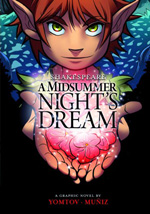 This graphic novel version of William Shakespeare's classic comedy of errors is filled with lots of silliness as several characters find themselves behaving in surprising ways and developing crushes on the most unlikely of individuals, in one case, even a furry animal with a donkey’s head. Readers unfamiliar with the original play may be a bit lost, but the humorous absurdity of love in various forms fills the book's pages, reminding readers of how foolish love can make us all. While few English teachers would choose this offering over the great bard's work since so much has been left out, it still provides a gentle, accessible introduction to his work while also poking fun at the vagaries of love.
This graphic novel version of William Shakespeare's classic comedy of errors is filled with lots of silliness as several characters find themselves behaving in surprising ways and developing crushes on the most unlikely of individuals, in one case, even a furry animal with a donkey’s head. Readers unfamiliar with the original play may be a bit lost, but the humorous absurdity of love in various forms fills the book's pages, reminding readers of how foolish love can make us all. While few English teachers would choose this offering over the great bard's work since so much has been left out, it still provides a gentle, accessible introduction to his work while also poking fun at the vagaries of love.
- Barbara A. Ward, Washington State University Pullman
These reviews are submitted by members of the International Reading Association's Children's Literature and Reading Special Interest Group (CL/R SIG) and are published weekly on Reading Today Online. The International Reading Association partners with the National Council of Teachers of English and Verizon Thinkfinity to produce ReadWriteThink.org, a website devoted to providing literacy instruction and interactive resources for grades K–12.